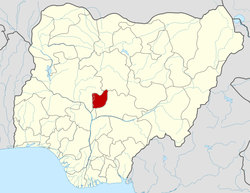Federal Capital Territory, Nigeria
| Federal Capital Territory | |
|---|---|
| Territory | |
| Nickname(s): Centre of Unity | |
 Location of Federal Capital Territory in Nigeria | |
| Coordinates: 8°50′N 7°10′E / 8.833°N 7.167°ECoordinates: 8°50′N 7°10′E / 8.833°N 7.167°E | |
| Country |
|
| Date created | 3 February 1976 |
| Capital | Abuja |
| Government | |
| • Ministry | Federal Capital Territory Administration (FCTA) |
| • Minister[1] | Bala Mohammed |
| Area | |
| • Total | 7,315 km2 (2,824 sq mi) |
| Population (2011 estimate)1 | |
| • Total | 2,238,800[2] |
| GDP | |
| Time zone | WAT (UTC+01) |
| ISO 3166 code | NG-FC |
| Website | fct.gov.ng |
| ^1 Preliminary results | |
The Federal Capital Territory is a federal territory in central Nigeria. Abuja, the capital city of Nigeria is located in this territory. FCT was formed in 1976 from parts of the states of Nasarawa, Niger, and Kogi. It is in the central region of the country. Unlike the States of Nigeria, which are headed by elected Governors, it is administered by the Federal Capital Territory Administration, headed by a minister appointed by the President.
Geography
The territory is located just north of the confluence of the Niger River and Benue River. It is bordered by the states of Niger to the West and North, Kaduna to the northeast, Nasarawa to the east and south, and Kogi to the southwest.
Lying between latitude 8.25 and 9.20 north of the equator and longitude 6.45 and 7.39 east of Greenwich Meridian, Abuja is geographically located in the center of the country.
The Federal Capital Territory has a landmass of approximately 7,315 km², of which the actual city occupies 275.3 km2. It is situated within the Savannah region with moderate climatic conditions.
Area councils
The territory is currently made up of six local councils, comprising the City of Abuja and five Local Government Areas, namely:
Natural resources in FCT
- Marble
- Tin
- Clay
- Mica
- Tantalite
- Lead/Zinc
- Marble
References
- ↑ See List of Abuja Federal Capital Territory Ministers for a list of prior ministers
- ↑ "Federal Capital Territory (Nigeria)". City Population. Retrieved 26 October 2015.
External links
| ||||||